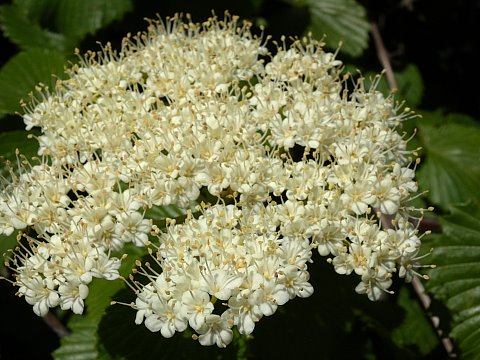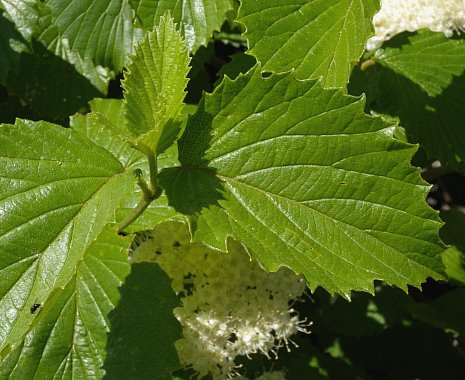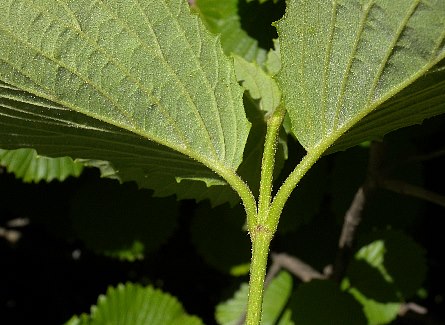
Flat-headed panicles of flowers about 2-4" across are produced from the tips of leafy stems or short spur-stems. The branching stalks of each panicle are light green to yellowish green and usually pubescent. Individual flowers are about ¼" across, consisting of a white corolla with 5 spreading lobes, a very short calyx with 5 teeth, 5 stamens, and a pistil with a single style. The stamens are strongly exerted from the corolla. The blooming period occurs from late spring to early summer for about 3 weeks. In each panicle, the flowers come into bloom at about the same time. The floral scent is malodorous. Afterwards, the flowers are replaced by small drupes about ¼" across that are globoid to ovoid-globoid in shape and blue-black at maturity. Each drupe contains a single stone (seed with a hard coat) that is ovoid in shape, somewhat flattened, and grooved along one side. The woody root system is shallow and branching, sometimes producing underground runners that form clonal offsets.
Cultivation: The preference is full or partial sun, moist to mesic conditions, and soil containing loam, silt, sand, or rocky material. This shrub has relatively few problems with disease organisms and it is easy to cultivate.
Range & Habitat: Southern Arrow-Wood is native to southern Illinois, where it is rare in natural areas. In other areas of the state, it may be encountered as an escape from cultivation. Habitats include thinly wooded slopes, openings in bottomland woodlands, woodland borders, streambanks, and fence rows. This shrub is cultivated throughout the state as an ornamental landscape plant, although it rarely seems to escape. However, it may be confused with the more common Viburnum recognitum (Smooth Arrow-Wood), which is sometimes regarded as a variety of Southern Arrow-Wood. Occasional disturbance is beneficial if it reduces competition from canopy trees.
Faunal Associations: The nectar and pollen of the unpleasantly scented flowers attract bumblebees, Halictid bees (Lasioglossum spp.), masked bees (Hylaeus spp.), Andrenid bees (Andrena spp.), flower flies (Syrphidae), dance flies (Empis spp., Rhamphomyia spp.), Tachinid flies, frit flies (Chloropidae), long-horned beetles (Cerambycidae), leaf beetles (Chrysomelidae), skin beetles (Dermestidae), click beetles (Elateridae), tumbling flower beetles (Mordellidae), and scarab beetles (Scarabaeidae). To a lesser extent, butterflies and skippers may visit the flowers for nectar; see Robertson (1929), Gosling (1986), Lovell (1900), and Lovell (1915). Other insects feed destructively on the wood, foliage, sap, flowers, and other parts of Southern Arrow-wood and other Viburnum shrubs (Viburnum spp.). This includes the Dogwood Twig Borer (Oberea tripunctata), Viburnum Leaf Beetle (Pyrrhalta viburni), weevils, larvae of the Arrow-wood Twig Gall Midge (Neolasioptera viburnicola) and other gall flies, plant bugs, the Viburnum Aphid (Aphis viburniphila) and other aphids, Forbe's Scale (Diaspidiotus forbesi), larvae of various sawflies, larvae of the Crocus Geometer (Xanthotype sospeta) and other Geometer moths, larvae of the Green Marvel (Agriopodes fallax) and other Noctuid moths, larvae of the Pink Prominent (Hyparpux aurora) and other Prominent moths, larvae of Sphinx moths (Darapsa spp.), larvae of Tortrix moths, and larvae of the Brown Scoopwing (Calledapteryx dryopterata). Butterfly larvae that feed on Viburnum shrubs include the Spring Azure (Celastrina ladon), Henry's Elfin (Callophrys henrici) in some locations, and later instars of the Baltimore (Euphydryas phaeton). See the Insect Table for more information.

The fruits of Southern Arrow-wood and other Viburnum shrubs are eaten by many kinds of songbirds and upland gamebirds, including the Northern Cardinal, Gray Catbird, Brown Thrasher, European Starling, Hermit Thrush and other thrushes, Great Crested Flycatcher, Blue-headed Vireo and other vireos, Northern Flicker, Ruffed Grouse, and Wild Turkey (see Bird Table). Some of these birds use Viburnum shrubs as nesting habitat and protective cover. Mammals that feed on these shrubs include the White-tailed Deer (foliage, twigs), Eastern Chipmunk (fruits, seeds), White-footed Mouse (fruits, seeds), Deer Mouse (fruits, seeds), and American Black Bear (Martin et al., 1951/1961; Hamilton, 1941; Romain et al., 2013; Noyce & Coy, 1990; Mosnier et al., 2008).
Photographic Location: Along a fence row near the University of Illinois in Urbana, Illinois. The photographed shrub is the more hairy variety of Southern Arrow-Wood, Viburnum dentatum deamii.

Comments: Southern Arrow-Wood is very similar in appearance to Smooth Arrow-Wood (Viburnum recognitum), except its leaf undersides are more hairy and they are never whitened. Another species, Viburnum molle (Soft-Leaved Arrow-Wood), differs from Southern Arrow-Wood by having leaves that are more cordate in shape and berries that are more narrowly ovoid in shape. The leaves of Soft-Leaved Arrow-Wood also tend to have more pairs of teeth along their margins (often exceeding 20 pairs per leaf). Another similar species, Viburnum rafinesquianum (Downy Arrow-Wood), is a smaller shrub (up to 6' tall) with smaller leaves (up to 3" in length). The leaves of Downy Arrow-Wood also tend to have fewer pairs of teeth along their margins (less than 10 pairs per leaf) than those of Southern Arrow-Wood. Within the Viburnum genus, species in the Arrow-Wood group have leaves with coarse dentate teeth and their flowers are malodorous. In contrast, species in the Viburnum group have leaves with fine teeth and their flowers are sweetly scented.